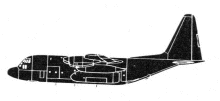Incident Overview

Description
The Lockheed HC-130P Combat King aircraft departed Portland International Airport, Oregon, USA at 17:20 PST on an instrument flight rules (IFR) flight en route to North Island Naval Air Station at San Diego, California. The purpose of the sortie was to conduct an overwater navigation evaluation. The aircraft, with callsign ‘King 56’, began the sortie with a normal takeoff, departure and climbout. One hour and 24 minutes after takeoff in level flight at FL 220 the mishap sequence began with the engineer commenting on a torque flux on the number 1 engine. Over the next three minutes, the operations of all four engines became unstable and eventually failed. The engineer called for number 1 propeller to be placed in mechanical governing. This would normally remove electrical inputs to the propeller through the synchrophaser. The pilot then called for all four propellers to be placed in mechanical governing. This action was consistent with treating this emergency as a four-engine rollback. There is no indication on the DFDR or the CVR as to whether or not the crew selected mechanical governing on any of the remaining three propellers. At the same time the crew was analyzing the emergency, they also declared an in-flight emergency with Oakland ARTCC and turned the mission aircraft east to proceed toward Kingsley Field, Klamath Falls, Oregon, approximately 230 miles away and approximately 80 miles from the coast. The Radio Operator radioed the USCG Humboldt Bay Station and notified them of the in-flight emergency. During the turn toward the shore the number 3 and number 4 engines once briefly recovered most of their torque. These increases are recorded by the flight data recorder. When the RPM on number 3 (the aircrafts last functioning engine) finally decreased below 94% RPM the last generator producing electrical power dropped off line due to low frequencies. As a result, at 18:46 Pacific Standard Time all electrical power was lost. After a brief period, power was restored to the equipment powered by the battery bus. From this point on, the aircraft glided to the attempted ditching. Cause: Fuel starvation.
Source of Information
https://fas.org/man/dod-101/sys/ac/docs/c-130-bar.htm#6.1https://fas.org/man/dod-101/sys/ac/docs/c-130-bar.htm#6.1Primary Cause
Torque flux on one engine caused instability and subsequent engine failure, triggering a four-engine rollback.Torque flux on one engine caused instability and subsequent engine failure, triggering a four-engine rollback.Share on:





